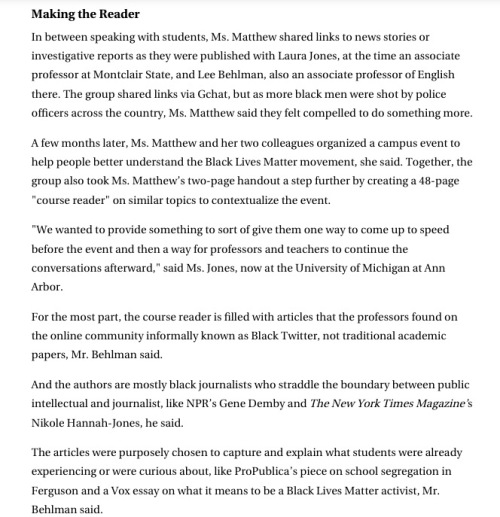I’ve been working with a small group to come up with strategies that will help faculty and their institutions respond to challenges to academic freedom. These challenges aren’t particularly new, but things move at the speed of Twitter, and so these challenges have increased and seem to follow a pattern, a professor (often but not always a member of an underrepresented minority) offers a comment on some controversial issue using unflinching rhetoric, and the rhetoric is used by different groups to pressure university administrators to discipline or fire the faculty member. The Steve Salita case is the one many of us know about. The reaction to these challenges tend to be performative–strongly worded letters of support, petitions, and, sometimes hashtags. Those are all well and good, but, as Tressie McMillan Cottom sighed on a Twitter, we need to do more than this. I wrote about social media in Written/Unwritten and in a special journal issue of the CLAJ, but I’ve felt helpless as I’ve seen the uptick in attacks. So I asked a group of people I trust and admire to help me think about what the academy and academics can do, particularly in this current moment when the stakes are so high. I’ve been working with Jessie Daniels, Kim F. Hall, Laura Jones, and McMillan Cottom to work out what those institutions and their faculty need. I’ve been happy to find that groups of people across multiple disciplines are doing similar work.
Here is the first part of our work–a list I’m sure will need revision as we learn more.
Next up: advice for, well, everyone.
General Information and Resoruces
AAUP Academic Freedom Tool Kit
MLA Academic Freedom Tool Kit
“1940 Statement of Principles of Academic Freedom and Tenure.” American Association
of University Professors. AAUP, 1970.
“MLA Statement on Academic Freedom (2009).” Modern Language Association. MLA,
Blog Posts
McMillan Cottom, Tressie. Everything But The Burden: Publics, Public Scholarship, And Institutions.
— Academic Outrage: When The Culture Wars Go Digital.
Zevallos, Zuleyka. Protecting Activist Academics Against Public Harassment.
—Sociology of Public Harassment Prevention Policies.
Op-Eds and Reporting
Allred, Kevin. “Trump’s Weaponized Base Is Going After Academics–I Know Because I Was Targeted.” The Establishment.
Daniels, Jessie and Arlene Stein. “Protect Scholars Against Attacks From the Right.” Inside Higher Ed.
Kamola, Isaac A. “Crashing the Academic Conversation.” The Chronicle of Higher Education (paywalled).
Morris, Catherine. “Professor Durden’s Firing Highlights Adjuncts’ Shaky Footing.” Diverse Issues in Higher Education.
Strauss, Valerie. “New Conservative ‘Watch List’ Targets Professors for Advancing ‘Leftist Propaganda’.” Washington Post.
West Savali, Kirsten. “For Black Scholars at PWIs, Speaking Truth to Power on Social Media Can Be ‘Professional Suicide.’” The Root.
Zeiser, John W.W. “Don’t Expect Liberalism to Come to the Defense of Keeanga-Yamahtta Taylor.” Los Angeles Review of Books.
Readings
Bilgrami, Akeel, and Jonathan R. Cole, eds. Who’s Afraid of Academic Freedom? New York: Columbia UP, 2015. Print.
Carvalho, Edward J., and David B. Downing, eds. Academic Freedom in the Post-9/11 Era. New York: Palgrave/Macmillan, 2010. Print.
Cloud, Robert C. “Keyishian v. Board of Regents.” Education Law. N.p., n.d. Web. 13 Mar. 2015.
“Committee A Statement on Extramural Utterances.” 1964. Rev. 1989. AAUP Policy Documents and Reports. 10th ed. Washington: AAUP, 2006. 32. Print.
Daniels, Jessie, and Joe R. Feagin. “The (coming) social media revolution in the academy.” Fast Capitalism 8, no. 2 (2011).
Ellison, Julie, and Timothy K. Eatman. “Scholarship in public: Knowledge creation and tenure policy in the engaged university.”
Finkin, Matthew W., and Robert C. Post. For the Common Good: Principles of American Academic Freedom. New Haven: Yale UP, 2009. Print
Grundy, Saida. “A History of White Violence Tells Us Attacks on Black Academics are Not Ending (I Know Because it Happened to Me).” Ethnic and Racial Studies. 40.11 (2017)
Hofstadter, Richard, and Walter P. Metzger. The Development of Academic Freedom in the United States. New York: Columbia UP, 1955. Print.
McMillan Cottom, Tressie. “Who Do You Think You Are?”: When Marginality Meets Academic Microcelebrity. Ada: A Journal of Gender, New Media, and Technology, No.7.
Marwick, Alice E. “I tweet honestly, I tweet passionately: Twitter users, context collapse, and the imagined audience.” New Media & Society 13, no. 1 (2011): 114-133.
Menand, Louis, ed. The Future of Academic Freedom. Chicago: U of Chicago P, 1996. Print.
Matthew, Patricia A. “Tweeting Diversity: Race and Tenure in the Age of Social Media” in Written/Unwritten: Diversity and the Hidden Truths of Tenure. Patricia A. Matthew ed, Chapel Hill: UNC Press, 2016. Print.
Nelson, Cary. No University Is an Island: Saving Academic Freedom. New York: New York UP, 2010. Print.
“Ramifications of the Supreme Court’s Ruling in Garcetti v. Ceballos.” Modern Language Association. MLA, Feb. 2010. Web. 13 Mar. 2015. http://www.mla.org/garcetti_ceballos.
Schrecker, Ellen. The Lost Soul of Higher Education: Corporatization, the Assault on Academic Freedom, and the End of the American University. New York: New, 2010. Print.
___, Ellen. 2010. “The Roots of Right-Wing Attacks on Higher Education.” The NEA Higher Education Journal: 71–82.
Shavisi, Arianne. 2015. “Epistemic Injustice in the Academy: An Analysis of the Saida Grundy Witch Hunt.” Academe Blog, May 20.
Tufecki, Zeynep ““Not This One” Social Movements, the Attention Economy, and Microcelebrity Networked Activism.” American Behavioral Scientist 57.7 (2013): 848-870.







